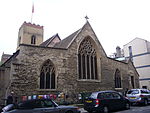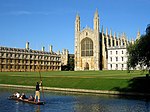Church of St Mary the Great, Cambridge

St Mary the Great is a Church of England parish and university church at the north end of King's Parade in central Cambridge, England. It is known locally as Great St Mary's or simply GSM to distinguish it from "Little St Mary's". It is one of the Greater Churches. It is designated by Historic England as a Grade I listed building.In addition to being a parish church in the Diocese of Ely, it is the university church for the University of Cambridge. As such it has a minor role in the university's legislation: for example, university officers must live within 20 miles of Great St Mary's and undergraduates within three. The church also hosts the "University Sermons" and houses the University Organ and the University Clock. The latter chimes the "Cambridge Quarters" which were later used by the clock tower of the Houses of Parliament ("Big Ben").
Excerpt from the Wikipedia article Church of St Mary the Great, Cambridge (License: CC BY-SA 3.0, Authors, Images).Church of St Mary the Great, Cambridge
Senate House Hill, Cambridge Newnham
Geographical coordinates (GPS) Address Phone number Website External links Nearby Places Show on map
Geographical coordinates (GPS)
| Latitude | Longitude |
|---|---|
| N 52.2053 ° | E 0.1182 ° |
Address
Great Saint Mary, The University Church
Senate House Hill
CB2 3PQ Cambridge, Newnham
England, United Kingdom
Open on Google Maps










